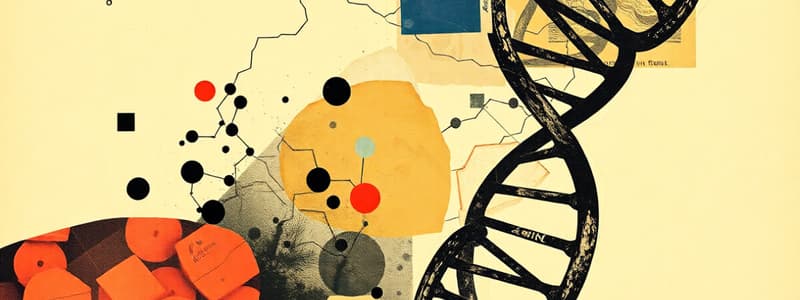Podcast
Questions and Answers
Associez chaque type de nucléotide avec sa définition correcte :
Associez chaque type de nucléotide avec sa définition correcte :
Dinucléotide = 2 résidus de nucléotides Trinucléotide = 4 résidus de nucléotides Décanucléotide = 10 résidus de nucléotides Oligonucléotide = Entre 10 et 50 nucléotides
Associez chaque type de polynucléotide à sa caractéristique :
Associez chaque type de polynucléotide à sa caractéristique :
ADN = Support de l'information génétique ARN = Prend le relais dans certains virus ADN mitochondrial = Présent dans les mitochondries ADN chloroplastique = Présent dans les chloroplastes
Associez chaque type de lien entre nucléotides avec sa description :
Associez chaque type de lien entre nucléotides avec sa description :
Liaison phosphodiester = Unit les résidus par des liaisons 3' - 5' Liaison hydrogène = Relie les bases azotées entre elles Liaison covalente = Forte liaison entre atomes Liaison ionique = Interaction entre ions opposés
Associez chaque type d'organisme à la localisation de son ADN :
Associez chaque type d'organisme à la localisation de son ADN :
Associez chaque définition de génome avec son contexte :
Associez chaque définition de génome avec son contexte :
Associez les bases azotées avec leur classe (purine ou pyrimidine) :
Associez les bases azotées avec leur classe (purine ou pyrimidine) :
Associez les ribonucléosides avec leur ribonucléotide correspondant :
Associez les ribonucléosides avec leur ribonucléotide correspondant :
Associez les ribonucléotides avec leur nombre de groupements phosphoryles :
Associez les ribonucléotides avec leur nombre de groupements phosphoryles :
Associez les déchets azotés avec leur équivalent en ribonucléotide :
Associez les déchets azotés avec leur équivalent en ribonucléotide :
Associez les préfixes des désoxyribonucléotides aux bases azotées correspondantes :
Associez les préfixes des désoxyribonucléotides aux bases azotées correspondantes :
Flashcards
Structure des monomères d'acides nucléiques
Structure des monomères d'acides nucléiques
Les monomères des acides nucléiques sont composés de trois éléments : une base azotée, un monosaccharide et un ou trois groupes phosphoryle.
Bases azotées
Bases azotées
Les bases azotées sont des molécules organiques cycliques contenant de l'azote. Elles sont de deux types : les purines (adénine et guanine) et les pyrimidines (cytosine, thymine et uracile).
Monosaccharide
Monosaccharide
Le monosaccharide présent dans les acides nucléiques peut être le ribose (pour l'ARN) ou le désoxyribose (pour l'ADN).
Groupes phosphoryle
Groupes phosphoryle
Signup and view all the flashcards
Nomenclature des nucléotides
Nomenclature des nucléotides
Signup and view all the flashcards
Dinucléotide
Dinucléotide
Signup and view all the flashcards
Polynucléotide
Polynucléotide
Signup and view all the flashcards
ADN
ADN
Signup and view all the flashcards
ARN
ARN
Signup and view all the flashcards
Génome
Génome
Signup and view all the flashcards
Study Notes
Introduction to Nucleic Acids
- In 1869, Friedrich Miescher discovered a substance in cell nuclei rich in nitrogen and phosphorus.
- He called it "nuclein."
- Later identified as deoxyribonucleic acid (DNA) in the 20th century.
- Nucleic acids are linear polymers of nucleotides, namely DNA and RNA.
Types of Nucleic Acids
- Two types of nucleic acids:
- Deoxyribonucleic acid (DNA)
- Ribonucleic acid (RNA)
- Crucial biological molecules.
- Their functions extend beyond storing genetic information.
Functions of Nucleic Acids
- Chemical mediators
- Nucleosides and nucleotides (e.g., AMP)
- Energy sources
- Nucleotides
- Enzyme cofactors
- Nucleotides and dinucleotides
- Biological catalysts (e.g., ribozymes in ribosomes)
- Heredity carriers
- DNA
- Heredity expression agents (e.g., RNA)
Nucleic Acid Monomers: Nucleosides and Nucleotides
- Nucleic acid monomers are classified into nucleosides and nucleotides.
- Nucleosides are formed by a nitrogenous base and a sugar (ribose or deoxyribose), linked by a β-N-glycosidic bond.
- Nucleotides are nucleoside phosphates; they consist of a nitrogenous base, a sugar, and one to three phosphate groups.
Nucleic Acid Composition
- Nitrogenous bases:
- Purines (adenine, guanine)
- Pyrimidines (cytosine, uracil, thymine)
- Sugars:
- Ribose (in RNA)
- Deoxyribose (in DNA)
- Phosphate groups: present only in nucleotides
Nomenclature of Ribonucleotides
- The document provides a table listing the ribonucleosides, ribonucleosides monophosphates, diphosphates and triphosphates for each base.
Functions of Nucleosides, Nucleotides, Dinucleotides, and Derivatives
- Nucleosides and nucleotides, in their free state, serve as coenzymes.
- They also act as chemical mediators or energy sources.
- Cyclic nucleotides, like cyclic AMP (cAMP), are intracellular messengers in signal transduction pathways.
DNA: The Genetic Material
- DNA carries genetic information in all cells except certain viruses where RNA takes this role.
- In eukaryotes, DNA resides predominantly in the nucleus but also in mitochondria and chloroplasts.
- The entire set of genetic material is known as the genome.
- Chromosomes are highly organized DNA structures that allow its efficient storage.
DNA Structure
- DNA consists of two polynucleotide chains that spiral to form a double helix.
- The bases pair in a specific way: adenine pairs with thymine, and guanine pairs with cytosine.
- The two strands run antiparallel to each other.
DNA Denaturation and Renaturation
- Denaturation is the separation of the two strands of DNA due to heat, pH changes, or chemical treatment.
- Renaturation involves the re-formation of the double helix when such treatment is removed.
- The temperature at which half of the DNA strands have separated is called the melting temperature, or Tm.
The Central Dogma of Molecular Biology
- DNA replicates, transcribing into RNA, and then translating into proteins.
- This is the fundamental process by which genetic information flows in cells.
- In more simple terms: DNA → RNA → Protein
RNA
- RNA is a single-stranded polymer of ribonucleotides.
- It is involved in several cellular functions, including protein synthesis.
- Types of RNA:
- Ribosomal RNA (rRNA)
- Transfer RNA (tRNA)
- Messenger RNA (mRNA)
Studying That Suits You
Use AI to generate personalized quizzes and flashcards to suit your learning preferences.




